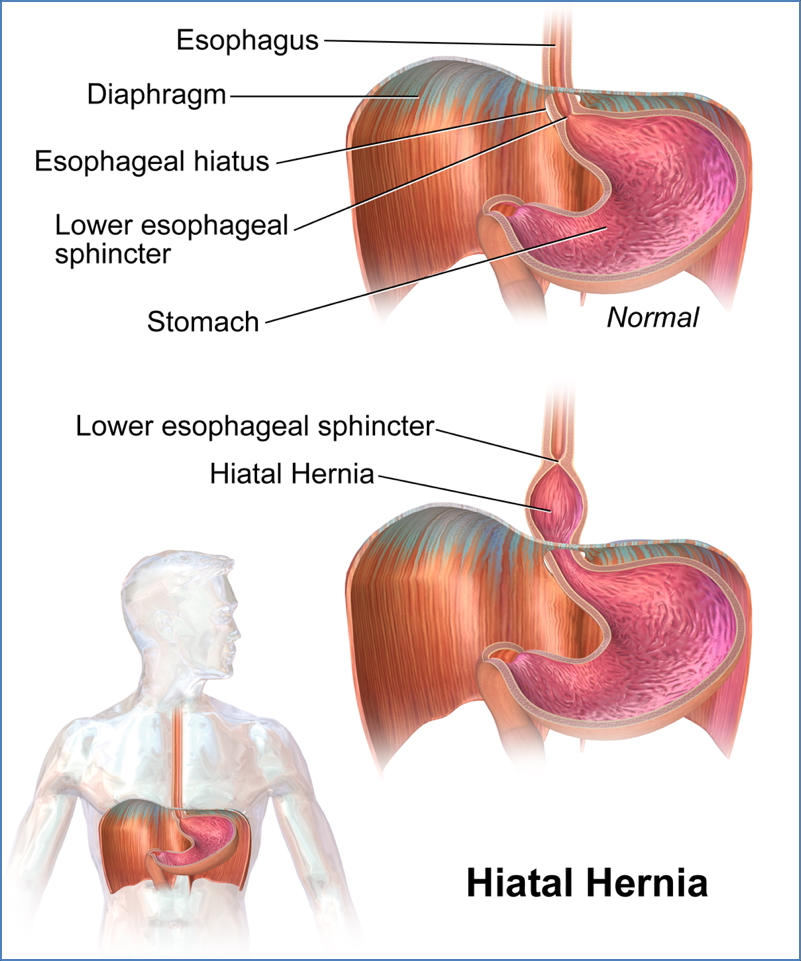Table of Contents
Overview – Hiatus Hernia
A hiatus hernia occurs when part of the stomach herniates through the oesophageal hiatus of the diaphragm into the thoracic cavity. It is a common cause of gastro-oesophageal reflux disease (GORD) in older adults, particularly with the sliding subtype. While many cases are asymptomatic, severe or complicated cases can result in oesophageal strangulation, reflux complications, and even malignant transformation in chronic GORD.
Definition
A hiatus hernia refers to the herniation of part of the stomach through the diaphragmatic oesophageal hiatus, either alone or along with the gastro-oesophageal junction.
Aetiology
- Weakness or tear in the diaphragmatic hiatus
- Exacerbated by increased intra-abdominal pressure
- Chronic coughing
- Obesity
- Pregnancy
- Straining
Pathophysiology
1. Sliding Hiatus Hernia (95%)
- Gastro-oesophageal junction and part of stomach slide above diaphragm
- Results in incompetent lower oesophageal sphincter
- Symptoms mimic GORD
- Prevalence: ~30% in individuals over 50 years
2. Rolling (Para-Oesophageal) Hernia (5%)
- Gastric fundus herniates beside the oesophagus
- Lower oesophageal sphincter remains functionally intact
- Higher risk of strangulation, volvulus, or ischaemia
- Symptoms are often mechanical: chest pain, dysphagia, dyspnoea

Clinical Features
- Asymptomatic (most cases)
- GORD symptoms:
- Heartburn, regurgitation
- Worsened when lying down; relieved on sitting up
- Pain – especially if torsion or strangulation in rolling hernia
- Shortness of breath – diaphragmatic compression
- Palpitations – due to vagus nerve irritation
Investigations
- Gastroscopy + biopsy
- Rule out Barrett’s oesophagus or oesophageal cancer
- Oesophageal manometry
- Detects lower oesophageal sphincter dysfunction
- Barium swallow or CT scan
- Visualise type and size of hernia
Complications
- Barrett’s oesophagus → Risk of oesophageal adenocarcinoma
- Strangulated rolling hernia → Ischaemia, necrosis
- Chronic GORD complications → Oesophagitis, strictures
Management
Conservative
- Weight loss
- Dietary modification: small meals, avoid alcohol/caffeine
- Positional strategies: elevate head of bed, avoid lying post-meals
Medical
- Antacids (e.g. Mylanta)
- PPIs (e.g. Omeprazole)
- Antiemetics (e.g. Metoclopramide)
Surgical
- Consider Nissen fundoplication (open or laparoscopic) if:
- Refractory to medical treatment
- Large hernia
- Risk of strangulation
- Barrett’s oesophagus present
Summary – Hiatus Hernia
A hiatus hernia is a structural defect in the diaphragmatic hiatus allowing part of the stomach to protrude into the chest. While sliding hernias often present with GORD symptoms, rolling hernias carry a higher risk of strangulation. Diagnosis is established via gastroscopy or imaging, with management tailored to severity. For further reading, visit our Gastrointestinal Overview page.